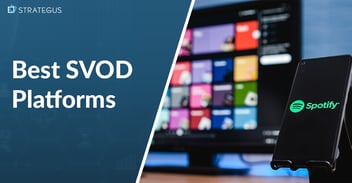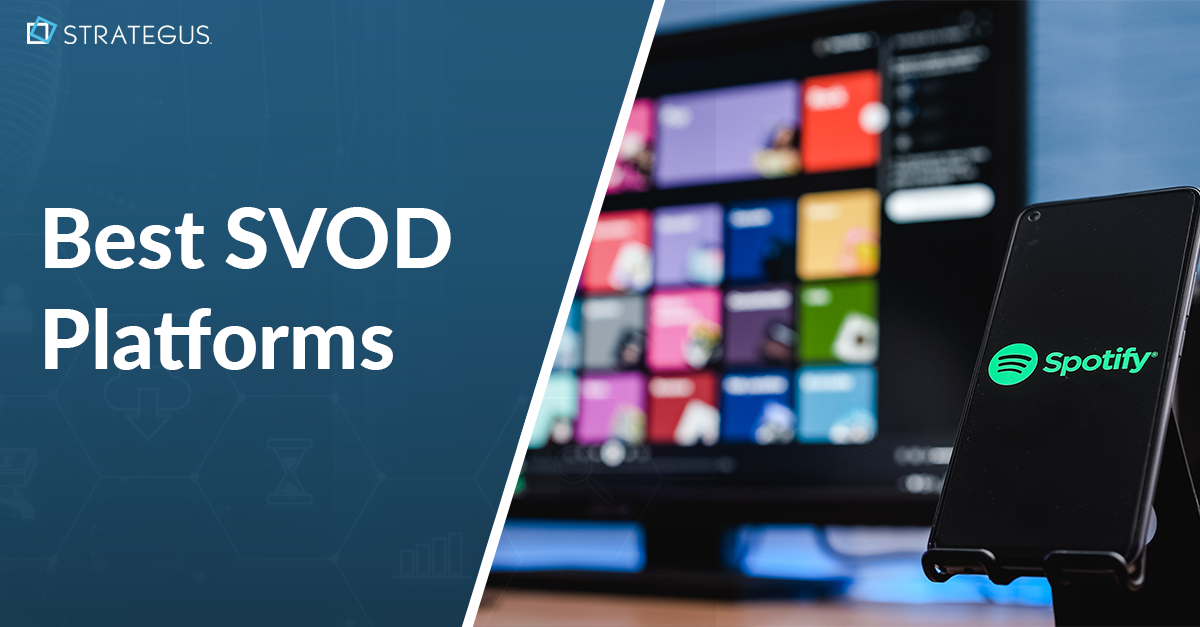- Home
- Strategus Blog
- Cross-Device Tracking And Targeting With CTV Advertising
Cross-Device Tracking And Targeting With CTV Advertising
 Andy Dixon
Andy Dixon
7 minutes read

Connected TVs, tablets, mobile phones, and other connected devices offer more ways to reach consumers, however, targeting audiences and measuring results across all of these devices remains a significant challenge.
As device ownership continues to grow, advertisers must understand the consumer journey and the digital touchpoints leading up to conversion.
Recently, consumer trends marked another milestone for streaming television, supporting CTV devices as the go-to for TV viewing, and marketing budgets have followed suit.
An eMarketer study estimated that $1 in $3 spent on TV advertising will go to CTV in 2025, up from less than $1 in $10 back in 2019.
Plus, smart TVs remain the most common connected TV (CTV) device in U.S. households, amounting to almost 50 million homes.
As a result, being able to retarget CTV viewers on additional devices could be the difference between a conversion and a consumer choosing a different option.
What is Cross-Device Targeting and Tracking?
-1.webp?width=710&height=417&name=9721811d-0b33-4a98-8177-03b439357a59%20(1)-1.webp)
Cross-device targeting is identifying and messaging one user across multiple devices. Integrating this capability allows advertisers to create a consistent user experience to deliver significant impact for brand awareness, conversions, and extended engagement.
With cross-device tracking, you can follow your customer across the entire user journey, from connected TV to laptop and other mobile devices.
Cross-device tracking determines which device belongs to a viewer and measures precise attributions so that advertisers can message consumers where they are in the buying process.
Plus, real-time reporting and analytics are essential to ensure ad dollars are connected to campaign KPIs while providing flexibility for mid-campaign adjustments.
If something isn’t working, you can find out quickly and adjust accordingly. Easily pivot campaigns based on audience insights and enhance effectiveness for long-term results.
Most of the time, TV viewers have their smartphones nearby as they watch. So, driving the first impression through connected TV and retargeting this same viewer with clickable ads draws them closer to action.
Data Collection Strategies to Identify Audiences
Connected TV isn’t like linear TV, where the goal is to place an ad in front of as many viewers as possible. Not only that, traditional TV presents too many challenges to track results accurately.
There are two main strategies for collecting data across multiple devices:
-
Probabilistic Data
This data utilizes different anonymous data points, ranging from website visits to the time of day and what operating system a person is on. As a result, probabilistic data is easily scalable and far more complex for sophisticated advertising solutions.
-
Deterministic Data
This data collection focuses on gathering information based on login information for IDs, websites, and apps that link different devices. This information reveals the user’s identifiers, such as how many times they log in to Sling, ESPN, or Spotify.
Delivering relevant ads to the suitable viewer on the right device and at the right time requires excellent precision and expertise. But more importantly, it’s entirely possible.
CTV should be an integral part of a cross-device marketing strategy as its adoption rate continues to grow, with more households embracing the digitization of television.
Consistency Delivers Impact

Getting people interested and engaged in an idea, brand, product, or service to encourage them to make a purchase, click on a call-to-action, or fill out a survey — is more impactful when advertisers meet viewers where they stream.
At Strategus, we’ve created a solution that bridges the gap between CTV advertising and sequential messaging through innovative retargeting tactics.
Encore Omnichannel technology recognizes a CTV ad viewed to completion and turns it into an actionable event, encouraging an online search, a click on a landing page, or specific actions related to your campaign.
This trackable technology only retargets viewers who finish watching one of the targeted CTV ads, avoiding irrelevant ad delivery, and providing focused audience targeting.
Here are some examples of scenarios where cross-device targeting makes perfect sense:
-
Launching a new product or service
-
Localized advertising for area-specific consumers
-
Off-season marketing to bolster busy seasons
-
First-party data activation to only message in-market audiences
-
Running a dynamic creative strategy
There are many strategies to use because cross-device targeting and tracking can be flexible to meet campaign objectives.
Online and Offline Attribution Measurement
Delivering a measurable and successful campaign is the purpose of cross-device tracking and targeting.
With CTV advertising, campaigns engage with consumers who will expand and reinforce customer bases. And delivering that messaging across devices influences action.
Though there can be measurement challenges, Strategus offers customizable online and offline attribution options so marketers can be as specific as possible.
Here are the different types of attributions that are possible for us include:
-
Who visited a website or physical store after watching a targeted ad
-
Who made a purchase, and where they made it from
-
How many products were purchased after the ad view
-
Online search comparisons before and after viewing the ad
-
Match offline purchasing and actions to ad exposure
\
Omnichannel Marketing Strategy

Cross-device targeting and tracking go hand in hand with omnichannel marketing strategies.
Omnichannel focuses on the consumer and seeks ways to engage new and existing ones with layered messaging over multiple channels.
It involves a range of ad formats, including display and video, to reach the same audience in a complex digital ecosystem.
The current path to purchase isn’t a straight line anymore. Consumers often start their journey with one channel and finish it on another.
Omnichannel Customers Use More Touchpoints
Advertising needs to enhance brand awareness to keep in step with customers to increase conversion rates.
Today’s streaming environment has abundant options and omnichannel capabilities to retain contact with buyers.
Traditional retailers with brick-and-mortar locations can leverage the digital domain to draw more shoppers to the physical store.
A major 14-month study to understand the shopping behaviors of customers interviewed 46,000 shoppers and found the following:
-
7% of shoppers were only interested in online shopping
-
20% of shoppers were store-only customers
-
73% of all shoppers used numerous channels throughout the customer journey
Benefits of Cross-Device Tracking and Targeting

Consumers interact with various devices throughout a given day, and here are the primary benefits for advertisers:
-
Scalability
Access more touchpoints and message relevant audiences in different markets to ensure your brand is at the top of people’s minds. If you’re considering a demand-side platform (DMP) for programmatic media buying, audience identifiers can be supplemented through first-party data activation for refined targeting at launch.
-
Precise Attribution Measurements
Cross-device tracking offers customer journey transparency, leading marketers to make smarter planning decisions and optimizations. For example, data collected from campaigns can inform ad frequency for each consumer, which creative is the most effective, and how the media mix is driving brand awareness.
-
Personalized Advertising
Serving the right ad in the right place and time controls the brand story and caterers to consumers' needs. Cross-device applies to every point of the purchase journey with a delivery that customizes ads for each step.
Seamless Cross-Device Tracking and Targeting
A cookieless future will change the ad industry with third-party cookies going away.
However, this doesn’t complicate retargeting strategies. With cross-device tracking and targeting, clients find their core customers and design ads to suit their needs.
Strategus ran the first-ever programmatic OTT/CTV campaign in 2015 and continues to move the industry forward. Partnering with Strategus brings ad operations proficiency to any omnichannel marketing strategy.
Our managed services have a wealth of experience delivering results for agencies and clients to put them in the position to maximize the latest advertising capabilities.
In addition to 24/7 campaign management, our Strategus Labs team continues researching and testing new ways to simplify CTV advertising for agencies and clients.
Contact us today for customized solutions to meet your business needs.
>>This is part of our guide to understanding connected TV advertising, click here to learn more

Andy Dixon is a seasoned Content Writing Specialist at Strategus, renowned for his expertise in creating engaging and impactful digital content. With over a decade of experience in content creation, Andy has honed his skills in a variety of niches, ranging from technology and marketing to education.
Strategus is a managed services connected TV(CTV) advertising agency with over 60,000+ campaigns delivered. Find out how our experts can extend your team and drive the result that matter most.
Talk to an Expert
Seeking a Custom CTV Strategy That Delivers?
What to read next

Best SVOD Platforms for Advertisers
The streaming wars have a new battlefront, and this time, it's all about your ad budget. Just a few years ago, SVOD meant "no commercials." Now, it...
12 minutes read

Third-Party Data Targeting for CTV: Benefits & Tactics
Third-party data. It’s a term that’s thrown around, and yet few take the time to detail its pros and cons — much less strategies for using...
7 minutes read

First-Party Data Targeting: Benefits and Tactics for CTV Advertising
First-party data is the information that companies collect directly from their customers rather than through intermediaries. Advertisers use this...
10 minutes read

Foot-Traffic Attribution: Tying Ad Impressions to In-Store Visits
The marketing funnel has changed. Today’s shoppers often begin researching products from the comfort of their homes and don’t set foot into a store...
8 minutes read















